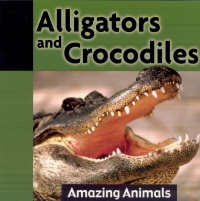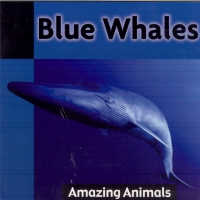| ________________
CM . . . . Volume XVI Number 25. . . .March 5, 2010. 
 |
Alligators and Crocodiles (Amazing Animals).
Angela Royston.
New York, NY: Weigl (Distributed in Canada by Saunders Book Co.), 2010.
24 pp., pbk. & hc., $9.95 (pbk.), $22.95 (hc.).
ISBN 978-1-60596-153-8 (pbk.), ISBN 978-1-60596-152-1 (hc.).
Subject Headings:
Alligators-Juvenile literature.
Crocodiles-Juvenile literature.
Grades 1-4 / Ages 6-9.
Review by Clancy Pryde.
***/4
|
| |
|
 |
Blue Whales (Amazing Animals).
Angela Royston.
New York, NY: Weigl (Distributed in Canada by Saunders Book Co.), 2010.
24 pp., pbk. & hc., $9.95 (pbk.), $22.95 (hc.).
ISBN 978-1-60596-149-1 (pbk.), ISBN 978-1-60596-148-4 (hc.).
Subject Headings:
Blue whale-Juvenile literature.
Grades 1-4 / Ages 6-9.
Review by Clancy Pryde.
***/4
|
| |
|

excerpt:
A blue whale takes in a large mouthful of krill and water. Then it closes its mouth and pushes the water out through its bristly baleen plates. The bristles trap the krill inside the whale’s mouth. The whale then swallows its meal whole. (From Blue Whales.)
In these two books from the “Amazing Animals” series, author Angela Royston introduces readers to three powerful creatures: alligators, crocodiles and blue whales. Each volume contains lots of fantastic full-colour photos and clear, simple sentences with limited vocabulary. A small glossary at the back of each book explains a few challenging words that are likely to be new to young researchers. Also included are text boxes detailing interesting facts in a bullet-point format, a table of contents and a simple index.
As both Alligators and Crocodiles and Blue Whales are part of a larger series, they are organized following a similar format. Two-page chapters cover high-interest topics, such as what the animals eat, where they live, their life cycle, natural predators and conservation issues. Also included is a surprising chapter on myths and legends related to the animals which would help young students make connections between the facts detailed in the books and stories with which they may already be familiar. As well, both books use bar graphs to compare the size of the animals to humans at different stages of development, have a world map showing where the animals live, and include current websites where students can find more information. All of these features allow for natural practice of important burgeoning skills.
Each of these engaging volumes will offer the youngest researchers a basic introduction to some exciting animals as they begin to learn to read for information and organize a report.
Recommended.
Clancy Pryde is a teacher in Toronto, ON.

To comment on this title or this review, send mail to
cm@umanitoba.ca.
Copyright © the Manitoba Library Association. Reproduction for personal use is permitted only if this copyright notice is maintained. Any other reproduction is prohibited without permission.
NEXT REVIEW |
TABLE OF CONTENTS FOR THIS ISSUE- March 5, 2010.
AUTHORS |
TITLES |
MEDIA REVIEWS |
PROFILES |
BACK ISSUES |
SEARCH |
CMARCHIVE |
HOME |

